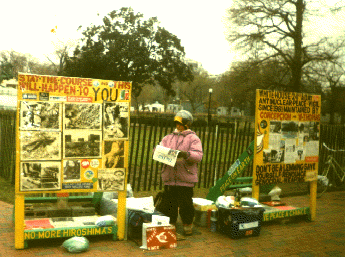Introduction
Mr. President, meet your closest neighbor: Concepcion Picciotto.
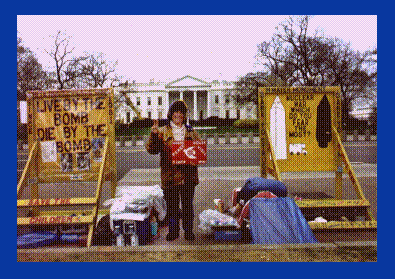
The tourists come and go on Pennsylvania Avenue; the presidents, the inaugurations, the dignitaries and the political scene is always changing. But some things remain the same in Lafayette Park, across the street from the White House in Washington, D.C.
She stands directly in front of the White House; she has been called "The Little Giant", a paradox, a mystery. Concepcion Picciotto is one who stays; through the rain and snow, the arrests, the abuses and threats through the years. Since 1981, Concepcion, or 'Connie' to her friends, has continued a vigil for world peace against the proliferation of weapons of mass destruction ; and that she would still be here 26 years later
The Vigil: Past To Present
The following excerpts are from the many articles that have been written by sympathetic and malicious reporters alike to give you a real PIECE OF HISTORY. I'd like to take this opportunity to Thank the many publications and supporters over the years who have contributed their ideas, energy, and compassion to keep the vigil going. Any representation of articles is for the purpose of exhibiting the TRUTH, and to tell the story only, not for any personal gain. This web site has been contributed by friends. Sincerely, Concepcion Picciotto.
March 1, 1997.
Reflections of the Past: The Early Years
In The Beginning: (Just click the article nameif you want to read the rest of the story.)
 THE WASHINGTON TIMES
THE WASHINGTON TIMES
TUESDAY, OCTOBER 12, 1982 By Kathleen Tyman
WASHINGTON TIMES STAFF
The new, carefully painted signs on the White House fence read "Wanted: Wisdom and Honesty," among other noble but obscure demands. They are the property of William Thomas, one of three self appointed protesters- in- residence.
Thomas and Concepcion Picciotto have been in their chosen spot on the sidewalk everyday for more than a year...on June 17, they held their ground and were arrested.
Houston Chronicle March 13, 1983
BY MONA MEGALLI
United Press International Sympathizers with demonstrator who was slain at White House continue their anti-nuclear vigil
WASHINGTON -- A guard at the gate calls them the regulars. the ones who sit, stand or pace Pennsylvania Avenue nearly every day picketing the White House.
People for or against nuclear war, abortion, the Vietnam War, budget cuts, and many other issues have made the northern front of the White House their forum.
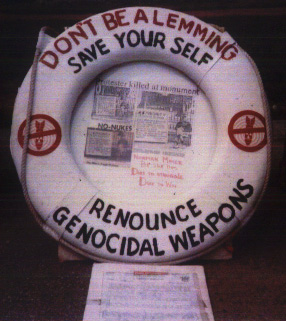
"Whatever makes the headlines one day, there's someone who comes in the next day to file for a First Amendment permit. It goes in cycles," says National Park Police spokeswoman Sandra Alley.
Some protest there for a few hours, others persist in their cause for years. Most remain anonymous. Norman Mayer didn't.
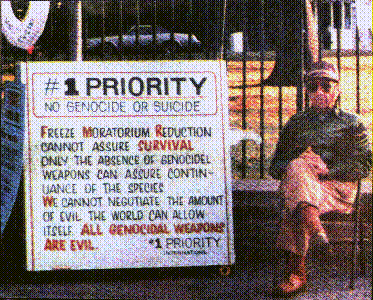
On Dec. 8, Mayer, 66, who had demonstrated daily before the White House against nuclear weapons since June 1982, besieged the Washington Monument for 10 hours before he was killed by police.
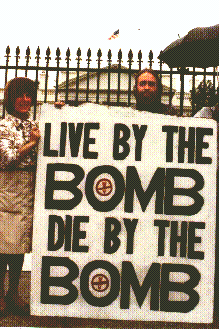
Something else happened after norman's death, the Park Police were worse than ever. It became apparant that new rules were being promulgated by the U.S.Park Police. Concepcion and Thomas fought them in Federal Court:
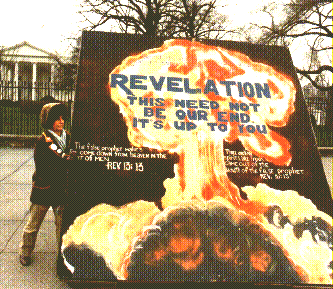 The Washington Times
The Washington Times
THURSDAY, MAY 5, 1983
By David Sellers
Washington Times Staff
A federal judge yesterday struck down new National Park Service regulations that limit the activities allowed as part of demonstrations on the sidewalk in front of the White House.
U.S. District Judge William Bryant issued a temporary restraining order, explaining that he failed to find that an emergency existed and that federal officials should have allowed a 30-day comment period on the regulations instead of putting them into effect immediately.
"I don't think there's any justification for not having that 30-day period:' Bryant said. "There's no articulated exigency."
Although there are 20 days left in the comment period, Bryant's order is good for only 10 days. Lawyers for both sides acknowledged that they may be back before the court at a later date; but they said they would try to work out any differences among themselves.
Assistant U.S. Attorney John Bates said he was not certain whether his office would appeal Bryant's order.
The new regulations, implemented April 22, prohibit individuals from exhibiting placards or signs on the White House sidewalk unless the person holds them at all times.
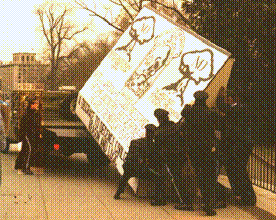 In spite of their resistance, the Park Police and the Secret Service won the battle, and the protesters were forced off the White House Sidewalk:
In spite of their resistance, the Park Police and the Secret Service won the battle, and the protesters were forced off the White House Sidewalk:
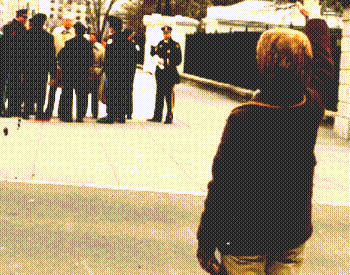 Concepcion salutes the Park Police, Hitler-style, as they take the signs away.
Concepcion salutes the Park Police, Hitler-style, as they take the signs away.
"It was disgraceful," she remembers.
Protesting on the White House Sidewalk had come to an end. A new way of life began for Thomas and Concepcion:
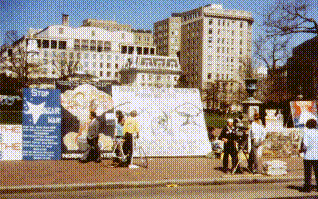
By Charles E. Wheeler
THE WASHINGTON TIMES
August 8,1984
Dozens of large protest signs have gone up in Lafayette Park since last year's National Park Service regulations restricting demonstrations on the White House sidewalk, and they're getting mixed reviews from locals and tourists.
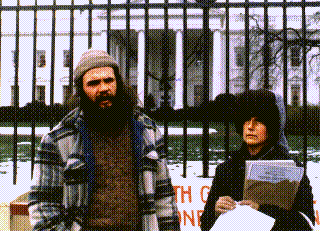 THE NORTH IRELAND TIMES
THE NORTH IRELAND TIMES
THURSDAY, AUGUST 8, 1985
Beaten, abused, living rough, they stand like some moral Maginot Line on a permanent White House peace vigil..
The man and the woman -Concepcion Picciotto and William Thomas - live under the stars, exposed to the rain and snow, summer and winter, without tent or sleeping bag. They feed like the pigeons and squirrels in the park, on what comes along, sometimes from the nearby McDonald's or Hardees bins.
It is a starkly contrasting picture in the capital of the world's greatest nation. On the south side, in the great mansion at 1600 Pennsylvania Avenue live Ronald and Nancy Reagan...across the street in Lafayette Park, without address or visible means of support, are Concepcion and William, with their messages of peace..
Word of Mouth,Inc. A Newspaper
Dedicated to the Population Majority
VOLUME III An International Publication Based in Jacksonville,Florida,USA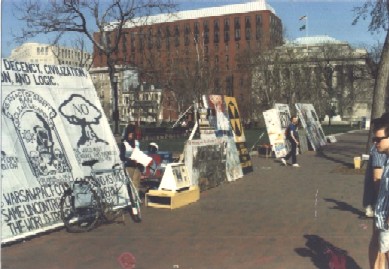
........ a very powerful advertising campaign was launched in Washington, District of Columbia, more than three years ago. The marketing director was one of the growing number of women in the business of public relations. Except that she was hired to do a huge campaign, -- with no prior experience! She got the job due to connections. So, she was offered only the experience of the job itself--with no salary.
She took the position anyway, knowing that its ultimate worth could not be measured in dollars; that its true reward would be in proving herself, opening doors only dreamed of by most of us. She experienced running an effective national campaign, and saw her work spread rapidly to a campaign of international repute.
Concepcion is the name of this woman. . Her name means "the beginning of creation or something"-- and she lives to conceive the idea of the real possibility of peace on earth through disarmament.
A LIFE OF PROTEST
By George Joseph Tanber
TOLEDO MAGAZINE, Decmber 4-10, 1988
 WASHINGTON: She's beginning her eighth winter in the neighborhood, yet she's never met the only other residents of the block.
WASHINGTON: She's beginning her eighth winter in the neighborhood, yet she's never met the only other residents of the block.
Mr. and Mrs. Reagan, meet Concepcion Picciotto.
Mrs. Picciotto - Connie to her friends -- occupies a humble patch of sidewalk in Lafayette Park, directly across from the entrance to the White House. She's there in the morning, when the tourists line up fa their visit to the executive mansion; she's there in the afternoon, when office workers flock to the park for picnic lunches; she's there in the evening, when rush hour traffic clogs Pennsylvania Avenue, and she there at 3 a.m.. when silence rules, save for the occasional stirring of a restless drunk on a nearby park bench.
Each day, and nearly every night since August 1981, Concepcion Picciotto has been there It`s her home. But she's not alone. She has her signs - "Live by the Bomb . . Die by the Bomb." "Civilized People do not Nuke Fellow Humans" -- her friend William Thomas, and the squirrels.
Mrs. Picciotto and Mr. Thomas demonstrate for living Co-founders of the White House Anti-Nuclear Peace Vigil, they claim the modern record for presidential protest They pass out pamphlets, they talk with passersby, and they display their signs Their message, they say, is simple: peace, freedom, and justice for mankind.
Not so simple, it seems, has been the response. They've been harassed and arrested by police, beaten and taunted by strangers, and ignored by most of their audience.
"We are sacrificing a lot." says Mrs Picciotto. who is 43. "And we are enduring a lot. But it's worth it.
IT'S A CURIOUS life for a woman who was born half a world away, in western Spain. Orphaned at a early age, Mrs. Picciotto was raised By her grand mother. When she died. young Concepcion decided to fulfill her lifelong ambition of emigrating to the United States. She arrived in New York at age 18 and found work as a secretary with the Spanish Consulate.
At 21, she met and married an ltalian businessman. The birth of a daughter, in 1973, was followed 20 months later by a messy divorce, the details of which Mrs. Picciotto declines to discuss The result, she says, was the loss of her husband, her daughter. her job, and her home.
She spent seven years trying to gain custodv of her child. Her odyssey began in the courts of Manhattan and took her to Albany, Madrid, and finally Washington. where she sought help from her congressman. Rebuffed at every turn. Mrs. Picciotto decided to take her case to the streets.
In 1980, she secured a part-time job as a babv sitter and began spending her off-days in front of the White House with her hand-painted signs calling for justice. She also wrote letters. One, to Lillian Carter, drew this response: "I sympathize with your case, but I am 80 miles away and have no power."
Gradually, as she befriended other demonstrator: Mrs. Picciotto`s repertoir expanded to include the anti-nuclear effort. Her zeal also grew. Finally, on warm summer day, halfway through Ronald Reagans first year as president, she collected her belongings and took a bus to Lafayette Park, where she has remained.
Shortly after, she joined forces with Mr Thomas, 40, who had begun protesting at the White House the previous year. (He had been expelled From Britain for discarding his U.S passport and declaring himself stateless).
Initially. Mrs Picciotto and Mr Thomas spent their days in front of the White House and their nights in the park. But in 1985 the National Park Service enacted restrictions on White House sidewalk demonstrations forcing the protestors across the street The protestors responded by increasing the number and size of their signs. At one time. Mrs Picciotto and Mr Thomas had 18 free-standing plywood signs in a row. The tallest was over 10 feet high.
Public concern and pressure from the Interior Department resulted in further restrictions two years ago. Today, no one is allowed more than two signs. and thev can't exceed 6 feet in height. This peeves Mrs Picciotto, who sees a conspiracy directed at forcing all protestors away from the area.
Rather than pout about her misfortune, though, she is content to sit on her milk crate, which doubles as her bed, and spread the word: "Stop building nuclear weapons, and let`s use the money to eliminate poverty."
MRS PICCIOTTO is a tiny woman, about 5 feet tall. she's well-mannered and articulate, although she speaks with a thick accent. She always wears a brown wig the size of a football helmet, covered with a scarf -- she won't say why -- and on a recent chilly afternoon she wore corduroy slacks, a wool sweater, and a down vest covered with protest badges. Her shabby appearance contradicts her penchant for tidiness; she constantly sweeps leaves and litter from her part of the sidewalk and neatly stacks her belongings behind the signs.
Her face is weather-beaten, but her dark eyes sparkle, reflecting the enthusiasm she has for what she calls her "life's work."
She survives. she says, on coffee, sweet rolls, and bread. Occasionally, friends bring her cheese, fruit, and sandwiches. She uses the restroom at a nearby Hardy's restaurant and showers infrequently at a downtown shelter for the homeless. She averages three hours of sleep a day, leaning against one of her signs.
Winters are the worst, says Mrs. Picciotto. No amount of clothing keeps the cold out, and she spends most nights pacing the sidewalk to avoid perishing.
Her livelihood comes from donations, she says. On a good day she may make $15. The money is spent on food, printing literature and paint for the "peace rocks" she began making several years ago. The rocks have become popular souvenirs for tourists, although Mrs Picciotto declines to charge for them.
Harassment is her biggest concern. It ranges from verbal abuse to physical harm: Eight years ago a U.S Marine punched her in the face. There also are threats from the homeless people who sometimes inhabit the park.
Park police are another problem, since sleeping is considered camping: -- a park offense -- and leaving posters unattended also is unlawful. Mrs. Picciotto and Mr. Thomas frequently play 'cat-and-mouse' with their adversaries. Sometimes they lose. Last summer Mr. Thomas, who calls himself an intellectual and spends a lot of time in the library, served 90 days in the pokey for camping.
THERE ARE good moments. too. Every week a woman from the Humane Society delivers a bag of peanuts to Mrs. Picciotto so she can feed her beloved squirrels. She sometimes receives mail from people she has become friends with. (The Vigil has a post office box). And after her bike was stolen, a young man employed at a nearby bicycle shop pieced together another for her Despite the hardships. the sidewalk across from the White House will remain Mrs. Picciotto's home for the foreseeable future.
"Certainly. I could go back to society." she says "I could make a !iving. But God has chosen a greater task for me". One of the squirrels grabs a peanut from Mrs Picciotto`s hand and scampers into the park.
"Imagine." she says,"I have seen people freeze to death in that park, right across the street from the house of the most powerful man in the world."
AT LAFAYETTE SQUARE IN FRONT OF THE WHITE HOUSE
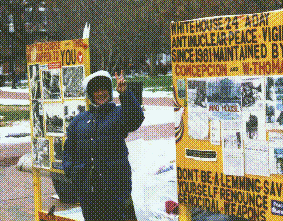
Daily Express
Malaysia
Sunday, Sept. 19, 1993
From James Sarda
PENNSYLVANIA Avenue in Washington D.C. is home to two famous residents both located diagonally across from the other.
One is the most powerful men on earth-who exercises great influence from a secure and comfortable white-washed 1818 century mansion.
The other is a woman who braves the wind, rain, sun and snow in a lonely round-the-clock street vigil alerting people to the horrors of weapons and nuclear war.
What inspires this intelligent woman to stay there? Her answer is quick: "I am in pursuit of Peace and Justice", says Concepcion, "to make people aware, so that they wake up to the reality that weapons of mass destruction threaten the extinction of mankind. The people have to make the change. The governments do not represent the people, they represent the corporations. We have to start from scratch. If the people lead, the leaders will follow. That's when revolutions happen, when the people cannot tolerate anymore," she concluded., "The people are in despair, the economy is crumbling, the crime is worse than ever, and the bombers are everywhere."
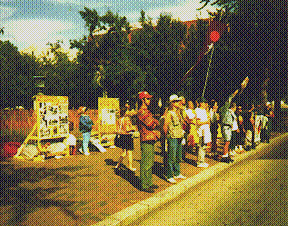
"People just want to be heard'" Concepcion added;
Concepcion has learned that if you keep trying, some people do listen:
Reflexion grafica por Sally Hanlon:
Revista Maryknoll, March 1992 Cargando la cruz ajena
 Concepcion Piccioto, oriunda de Espana, lleva 10 anon dia y noche frente a la Cas Blanca en vigilia permanente por la paz?
Concepcion Picciotto, a native of Spain, has spent 10 years [97: now 16 years] of her life in front of the White House day and night in a permanent vigil for peace.
Concepcion Piccioto, oriunda de Espana, lleva 10 anon dia y noche frente a la Cas Blanca en vigilia permanente por la paz?
Concepcion Picciotto, a native of Spain, has spent 10 years [97: now 16 years] of her life in front of the White House day and night in a permanent vigil for peace.
What will I contribute to peace?
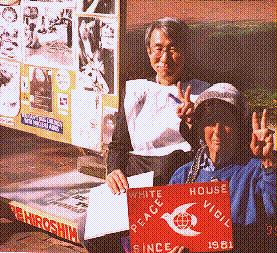
Concepcion has been an inspiration to Peace Activists from around the world who come back year after year to have their picture taken with her and to hope they will be the next recipient of the beautiful and famous "peace rocks" she paints with the word "Peace" in several different languages, which she also speaks.
These people tell her, "Please don't give up,we need you here!", and "You do this for all of us, and for the children." That's why she does it, for the children.
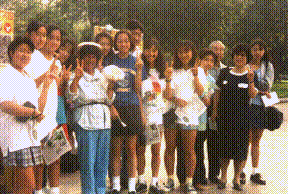
"We must teach the children to respect and value LIFE, not material things. That's the only way we will have peace," she said at a recent interview in Washington. "The people must demand that the governments stop using the people's money to buy weapons, and use it for the people's needs, such as education, jobs, housing and health care; People need to live with dignity. If the people have what they need, there would be no reason to fight," added Concepcion.
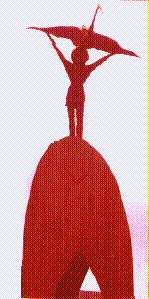 No More Hiroshimas
One of Concepcion's Fliers depicts the little girl, Sadako Sasaki, who died on October 25, 1955, from leukemia, "the bomb sickness", which killed many for years after the war. This statue was erected in Hiroshima Peace Park, in 1958, in memory of Sadako and the thousands of children who died at Hiroshima. Sadako is holding a golden crane in outstretched arms atop a granite mountain. The legend in Japan is that if you fold a thousand paper cranes, the angels will grant your wish. Every year, on August 6 --Peace Day, children come from all over the world to place paper cranes at the base of the statue.
No More Hiroshimas
One of Concepcion's Fliers depicts the little girl, Sadako Sasaki, who died on October 25, 1955, from leukemia, "the bomb sickness", which killed many for years after the war. This statue was erected in Hiroshima Peace Park, in 1958, in memory of Sadako and the thousands of children who died at Hiroshima. Sadako is holding a golden crane in outstretched arms atop a granite mountain. The legend in Japan is that if you fold a thousand paper cranes, the angels will grant your wish. Every year, on August 6 --Peace Day, children come from all over the world to place paper cranes at the base of the statue.
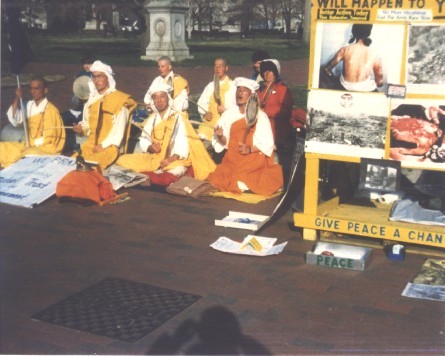
The White House Anti-Nuclear Vigil is one of those constant reminders that Free Speech is alive and well in the United States of America: even in Washington. Or, is it?
The "Regulations" being implemented by the National Park Service have slowly, subtly, consistently pushed the First Amendment frontliners to the back of the park, away from the White House and the tourists, but the Park Police don't let up.
After Clinton's second Inauguration, we moved the signs back to the front of the White House, as we have done since Reagan's second term. The Park Police were rude, and said, "No, you can't move those signs until the supervisor gives the order."
Well, the signs were moved, but we have suffered constant harassment since then. The police have locked the bathrooms, and they watch every minute to see if I leave the signs. Thanks to friends, I do get a break occasionally; and the vigil goes on...



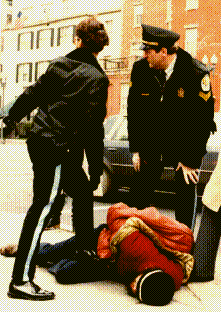
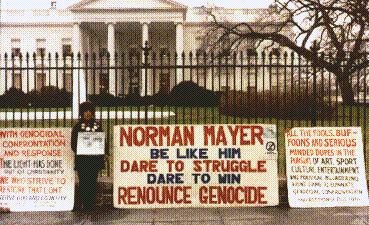
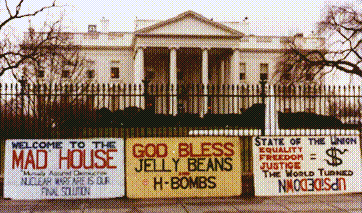



 The Washington Times
The Washington Times In spite of their resistance, the Park Police and the Secret Service won the battle, and the protesters were forced off the White House Sidewalk:
In spite of their resistance, the Park Police and the Secret Service won the battle, and the protesters were forced off the White House Sidewalk:  Concepcion salutes the Park Police, Hitler-style, as they take the signs away.
Concepcion salutes the Park Police, Hitler-style, as they take the signs away.
 THE NORTH IRELAND TIMES
THE NORTH IRELAND TIMES



 Concepcion Piccioto, oriunda de Espana, lleva 10 anon dia y noche frente a la Cas Blanca en vigilia permanente por la paz?
Concepcion Piccioto, oriunda de Espana, lleva 10 anon dia y noche frente a la Cas Blanca en vigilia permanente por la paz? 



